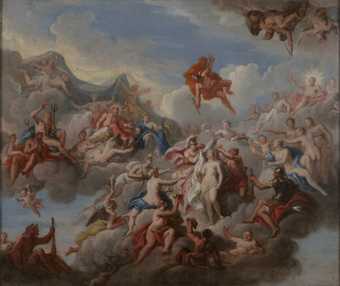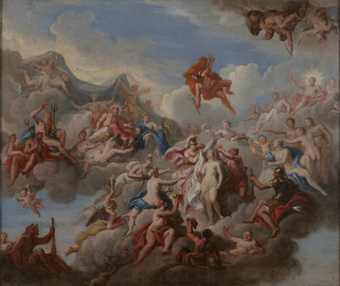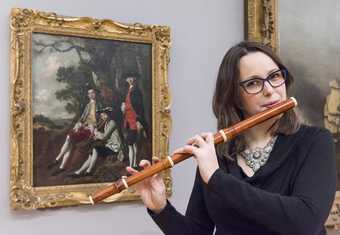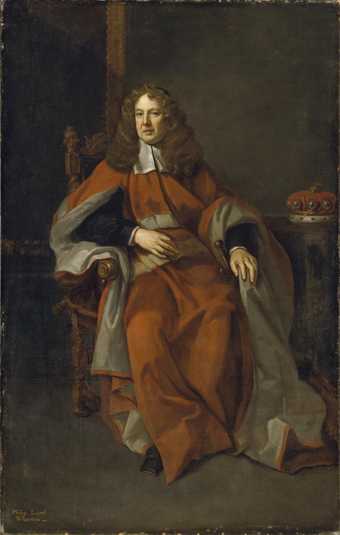
John Closterman The Children of John Taylor of Bifrons Park 1696 National Portrait Gallery, London
Introduction
This exhibition covers the reigns of the last Stuart monarchs, from the restoration of Charles II in 1660 to the death of Queen Anne in 1714. In Europe, it was an age when art was used to support and advertise the authority of the monarchy. While Louis XIV and his court at Versailles provide the leading example of this culture, the focus here is on Britain – a Protestant nation, where the power of the monarch was no longer absolute.
Across the period, major events took place – the restoration of the monarchy in 1660; the Revolution of 1688; the consequent central positioning of Parliament; the rise of party politics; the Union of England and Scotland; and wars that shaped Britain’s role in Europe. It is in this period of change – and the journey from the glamorous, court-centred world of Charles II to the political climate of the reign of Anne – that the association between art and power is explored.
The later Stuart period was an age of hierarchy. Displays of magnificence to express status and influence were used by royal courts, aristocrats and the rising political elite. Works of art on a grand scale; the use of illusion and perspective to awe-inspiring effect; and the visual impact of the great buildings of the age such as St Paul’s Cathedral, Chatsworth and Blenheim Palace, were persuasive statements of power.
Room 1: Restoration
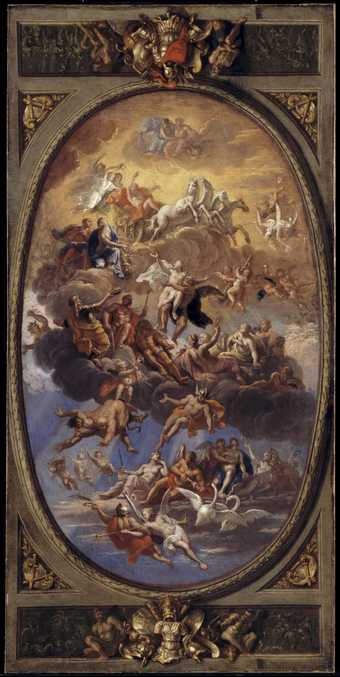
Antonio Verrio
Sketch for a Ceiling Decoration: An Assembly of the Gods (c.1680–1700)
Tate
The Restoration of the monarchy in 1660 followed years of upheaval: civil war, the beheading of King Charles I, and the government of Oliver Cromwell. A return to monarchy, and Charles II’s arrival in England from exile, were received with public joy. Poets, such as John Dryden, celebrated the King in exaggerated, idealised terms. They compared his power to that of gods and Roman emperors. His restoration was presented as miraculous and God-given, bringing peace and prosperity. The Coronation, on a day of sunshine, was a spectacle full of colour and vitality. It was designed to impress upon people the wonder and dignity of the monarchy.
With the return of the King came the need to re-establish the royal court as the centre of power, and a place of magnificence and splendour. Lavish surroundings, as well as pomp and ceremony, were seen as essential to reinforce the King’s authority and inspire respect. Those employed in the King’s household, under the Lord Chamberlain, were responsible for the public presentation of the monarch. They included the artists Peter Lely, the King’s Principal Painter; Samuel Cooper, his official miniaturist; and the mural painter, Antonio Verrio. They created the portraits and visions of the King that were circulated to both a domestic and an international audience.
Room 2: The Restoration Court
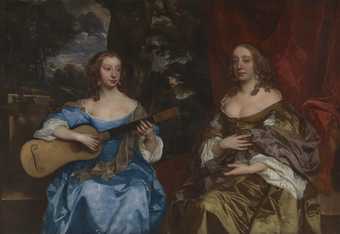
Sir Peter Lely
Two Ladies of the Lake Family (c.1660)
Tate
The Restoration of the monarchy returned the royal court to the centre of the nation’s cultural life. It was a place of influence and a leader of fashion, and set the standard for levels of magnificence and splendour. It was also a place to be seen. Ambitious men and women competed to gain prominent roles and the favour of the King.
Artistic patronage and fashion were set by the most important courtiers and large sums were spent keeping up with court taste. Portraits offered messages about power and status, and their display demonstrated important connections. Peter Lely, the King’s painter, was the most sought-after artist. His portraits of ‘court beauties’, dressed in expensive silks, capture more than any others the tone of the Restoration court. While the King and his followers were painted by Lely, the Queen, Catherine of Braganza, chose Jacob Huysmans. He provided for her, and her mainly fellow Catholic supporters, a separate visual identity.
While marriages were arranged to bring together powerful families, the King and influential courtiers often had intimate relationships with women other than their wives. These women (or mistresses) were among the most powerful at court. They used their portraits, which often included their children with the King, to express their influence. What some saw as the indulgence and immorality of the Restoration court was increasingly condemned. Even the King’s favourite, the Earl of Rochester, became a vocal critic.
Room 3: The Religious Interior
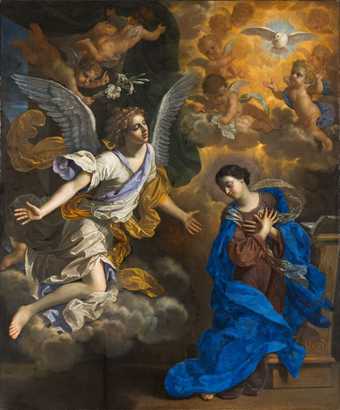
Benedetto Gennari The Annunciation 1686 Collection of The John and Mable Ringling Museum of Art, the State Art Museum of Florida, Florida State University, Sarasota, Florida
In the seventeenth century religion was a deeply divisive subject. The English Civil War had seen the removal of the monarch. In 1662, shortly after Charles II’s restoration, the Church of England was re-established with the King as its head. The country had witnessed the destruction caused by the civil war, and Puritan attacks on art in churches. There was a desire to unite the Protestant country, and to restore cathedrals and churches as suitable settings for worship. A wide range of opinion about the use of images still existed, however. Some rejected all images, fearing they would be worshipped instead of God. Others thought that biblical narratives and elaborate decoration were appropriate in religious settings.
The late Stuart period was one of widespread anti-Catholic feeling in Britain. The 1678 Popish Plot – the alleged Catholic conspiracy to assassinate Charles II and restore Catholic rule – caused fear among Protestants. The Catholic chapels in London, at St James’s Palace and Somerset House, where the Catholic consorts Catherine of Braganza and Mary of Modena enjoyed freedom of worship, provided a focal point for the Catholic community. They placed an emphasis on lavish decoration, music and large painted altarpieces with images of saints.
While their atmosphere fascinated some, such as the diarist Samuel Pepys, they were controversial places. At moments of intense anti-Catholic feeling they were the focus of violent protest.
Room 4: Illusion and Deception
Trompe l’oeil paintings – painted to trick the eye into thinking the objects depicted are real – were highly fashionable in the late Stuart period. Viewers of these pictures, which were sometimes carefully positioned to enhance the illusion, were delighted by their skilful deception. Such works were collected at the royal courts of Europe, and in England by Charles II.
This type of painting was also popular among members of the Royal Society. Founded in 1660, the society promoted scientific experimentation and exploration of the natural
world. Dutch artist Samuel van Hoogstraten arrived in London in 1662. He saw a relationship between art and science and became part of the circle that surrounded the Royal Society. He described his paintings as ‘perfect mirrors’ of nature. But they were also experiments in optical illusion that played with the representation of space.
The diarist Samuel Pepys was an enthusiastic witness to the wonder of trompe l’oeil pictures. He was entranced by Van Hoogstraten’s work. He also admired the realism of still life and flower paintings by other Dutch artists working in Britain. They were unlike anything he had seen before. These paintings pushed the boundaries of what was considered new and extraordinary.
Room 5: Wren and Baroque Architecture
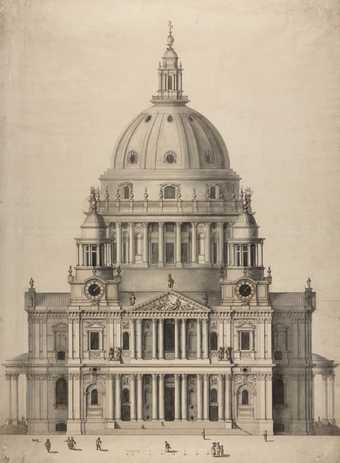
Sir Christopher Wren, Nicholas Hawksmoor St Paul's Cathedral: Elevation from West c.1702 All Souls College, Oxford
The late Stuart period was the age of English baroque architecture. This grand style is particularly associated with the court architect Christopher Wren, Surveyor-General of the King’s Works. Wren’s architectural design was guided by the principles of mathematics and geometry. He looked to classical architecture and was also familiar with contemporary French architecture. He had visited Paris during the London plague year of 1665–6, and knew Louis XIV’s building projects through prints. He absorbed French ideas about visual magnificence. He recognised that architecture was a public art, with a political use. Wren’s impressive buildings expressed magnificence, strength and beauty, and were symbols of the nation.
Wren was responsible for many of the great building projects of the era. These included St Paul’s Cathedral (following the Fire of London in 1666), Hampton Court Palace and Greenwich Hospital. Wren’s buildings were impressive works of engineering. Their scale and form, and features such as large columns, porticos (to emphasise entrance ways), ornament and domes, conveyed grandeur, power and royal magnificence. Their ambition and effect influenced a younger generation of architects. Among them was Nicholas Hawksmoor who worked in Wren’s office.
Room 6: Country Mansions and Courtly Gardens
From the late 1680s, Wren’s royal palaces and public buildings served as inspiration for country mansions. Grand houses built for wealthy aristocrats, which had once been relatively plain, were made more splendid. The architects William Talman, Nicholas Hawksmoor and John Vanbrugh designed buildings lavish in scale such as Chatsworth House and Blenheim Palace. Rich ornament, decorated skylines and the use of the ‘giant order’ – columns or pilasters the height of the building – increased the sense of scale and gave these grand houses a powerful visual impact.
The elaborate gardens of Louis XIV in France, and those of William and Mary in the Netherlands, influenced those of the English aristocracy. They had ornamental parterres (grass, gravel and planting in intricate patterns); classical statues; groves criss-crossed with walks; and fountains with impressive jets of water. There were also aviaries with colourful imported birds.
These details can be seen in paintings and engravings of grand estates. Bird’s-eye views, by artists such as Leonard Knyff and Jan Siberechts, showed off the houses and gardens of the wealthy. Set in the surrounding countryside, they indicated the wealth and status of owners and their families.
Room 7: Painted Interiors
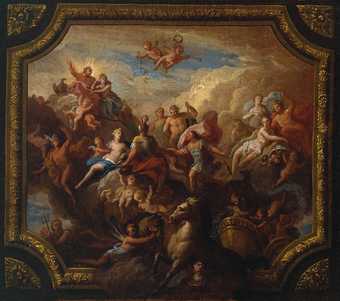
Sir James Thornhill
The Apotheosis of Romulus: Sketch for a Ceiling Decoration, Possibly for Hewell Grange, Worcestershire (c.1710)
Tate
Illusionistic mural painting was an important feature of late Stuart interiors. Ceilings, staircases and walls of palaces, country houses and public buildings were painted with subjects taken from ancient history and classical mythology. They were grand in scale and cost vast sums of money. For months, or even years, large areas of houses were given over to scaffolding for teams of artists to work.
The arrival in England in 1672–3 of the Italian mural artist Antonio Verrio opened people’s eyes to the power of painted interiors. His decoration of rooms at Windsor Castle for Charles II
influenced many aristocratic patrons over the following decades. Painted interiors were both an expression of fashionable taste and a spectacle for visitors. Artists transformed plain rooms into three-dimensional worlds. Perspective draws the eye upwards towards the heavens full of gods and goddesses, while clouds and figures seem to spill into the real world. Some ceilings contained political messages, but it would have been the visual impact of the illusion that impressed most viewers.
This room brings together sketches by the leading mural artists – Antonio Verrio, Louis Laguerre, Louis Chéron and James Thornhill – for large painted schemes. From quick ink drawings to oil sketches presented to clients, they reveal the creative process for these complex spaces.
Room 8: Beauty
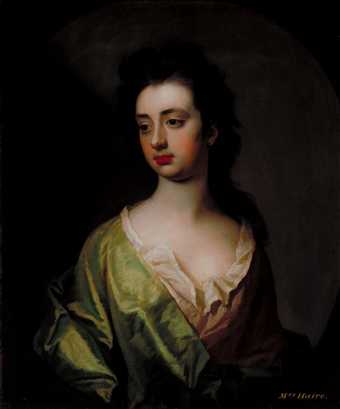
Michael Dahl
Portrait of Mrs Haire (1701)
Tate
In late Stuart society, beauty was considered a valuable quality for women. It was celebrated in poetry and painting to flatter individuals and honour their families. This room brings together examples from two portrait sets of ‘Beauties’ created in the 1690s: Godfrey Kneller’s Hampton Court Beauties, and Michael Dahl’s Petworth Beauties.
The Hampton Court Beauties, a set of eight full-length portraits, was commissioned by Mary II in 1690–1. The chosen women were considered the most beautiful at her court. The set of Petworth Beauties was commissioned by the 6th Duke and Duchess of Somerset for their country mansion Petworth House that was being transformed into a magnificent baroque palace. The sitters represent their family and connections. They range in age from mid-teens to their thirties. Their portraits present an ideal model of court beauty. The expensive silks, grand settings and beautiful flowers in the portraits all reflect the beauty and morals of the sitters. The portraits were designed to compliment them and express their nobility.
The Hampton Court Beauties were displayed by Mary II in her Water Gallery by the River Thames at Hampton Court Palace. It was a luxurious space with lacquerwork, flower paintings, mirrors and displays of blue and white china. The Petworth Beauties were displayed with mirrors between them. This offered viewers a full-length glimpse of themselves alongside the portraits. These settings, with glittering candlelight, would have enhanced the messages about ideals of courtly and aristocratic beauty that the portraits communicate.
Room 9: Triumph and Glory
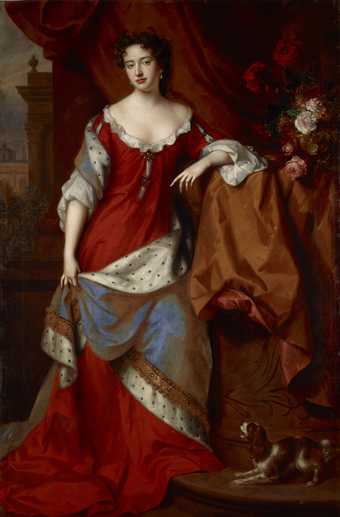
Willem Wissing Queen Anne, when Princess of Denmark c.1685 National Galleries of Scotland
For almost the entire reigns of William III and Anne (1689–1714), Britain was at war. The Nine Years’ War (1688–97) and the War of the Spanish Succession (1701–13) dominated the times. Britain was part of the Grand Alliance with the Dutch Republic, Holy Roman Empire, Spain and Savoy. They were engaged in battle against French dominance in Europe.
Images of the monarch represented not just their own authority but also the might of the nation. The magnificent portraits, battle scenes and commemorative medals of the French King, Louis XIV, were leading examples of how to glorify supreme power and victory. They were models that were imitated by other European leaders. Equestrian images of William III, and battle scenes showing him victorious before his troops, reinforced ideas about his and Britain’s strength. They were collected and displayed by the King’s supporters. Medals were circulated that promoted his power while mocking that of Louis XIV.
As a female monarch, Queen Anne’s image was not used to represent military victory. The military leader, the Duke of Marlborough, became a national hero. His victories, such as the Battles of Blenheim (1704) and Ramillies (1706), were celebrated in national Thanksgiving services at St Paul’s Cathedral. The Queen herself promoted peace. The Peace of Utrecht in 1713 was a joyous occasion. It was celebrated with a display of fireworks on the Thames.
Room 10: The Age of Politics
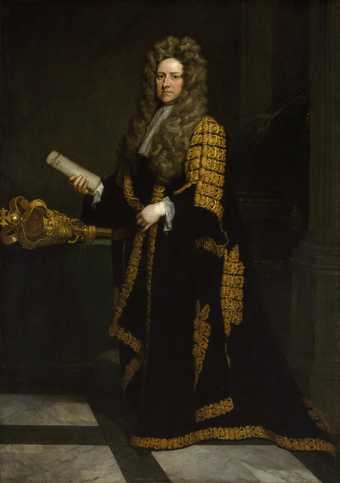
Sir Godfrey Kneller
John Smith, Speaker of the House of Commons (c.1707–8)
Tate
The Revolution of 1688–9 limited royal power. Parliament became central to the political life of the nation. It was the age of the rise of political parties. While the Whigs opposed absolute monarchy and Catholic influence and supported the Protestant succession, the Tories were the party that identified with the traditions of Stuart rule.
From 1694, elections were held every three years and party politics became a constant concern. Politics could be discussed in coffee houses where newspapers were available; political clubs, such as the Whig Kit-Cat Club, became alternative places of debate, away from the royal court and government.
In Queen Anne’s reign (1702–14), the power, influence and cultural leadership of the royal court faced increasing competition from wealthy aristocrats and the new political elite. The court, however, remained an important focus. In an age of strict social hierarchy, royal and aristocratic authority continued. At court, people could still profit through gaining the personal favour of the Queen.
Belief in magnificent display to express power and status continued. Godfrey Kneller, Principal Painter to successive monarchs, was the leading portrait painter. He produced full-length images that aimed to present his sitters as noble and dignified. As well as courtiers and leading aristocrats, patrons included wealthy professionals and politicians.

